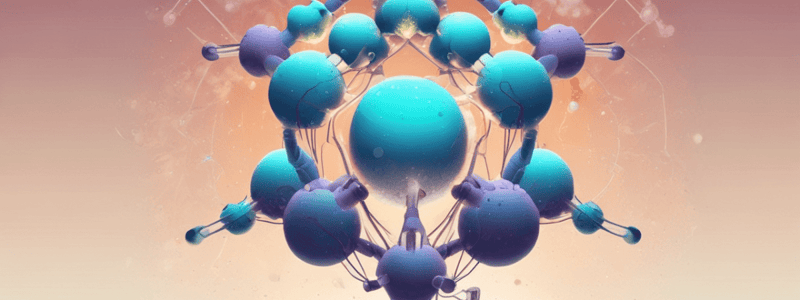Podcast
Questions and Answers
What are the two main categories of matter?
What are the two main categories of matter?
- Pure substances and mixtures (correct)
- Solutions and suspensions
- Elements and compounds
- Homogeneous and heterogeneous mixtures
What is an example of a heterogeneous mixture?
What is an example of a heterogeneous mixture?
- Sea water
- Rocks (correct)
- Air
- Gold (Au)
What is the classification of sugar (C12H22O11)?
What is the classification of sugar (C12H22O11)?
- Homogeneous mixture
- Pure substance (compound) (correct)
- Element
- Mixture
What is the classification of oxygen gas (O2)?
What is the classification of oxygen gas (O2)?
What is the classification of milk?
What is the classification of milk?
What is the classification of steel (alloy of iron and carbon)?
What is the classification of steel (alloy of iron and carbon)?
What is a mixture?
What is a mixture?
What is the main difference between pure substances and mixtures?
What is the main difference between pure substances and mixtures?
What is an example of a homogeneous mixture?
What is an example of a homogeneous mixture?
What is an example of a diatomic molecule?
What is an example of a diatomic molecule?
What is the classification of air?
What is the classification of air?
What do diagrams (a) and (b) represent?
What do diagrams (a) and (b) represent?
What is a characteristic of compounds?
What is a characteristic of compounds?
What is a characteristic of mixtures?
What is a characteristic of mixtures?
What do diagrams (a), (b), and (c) have in common?
What do diagrams (a), (b), and (c) have in common?
Why is it essential to understand the distinction between elements, compounds, and mixtures?
Why is it essential to understand the distinction between elements, compounds, and mixtures?
Which of the following is a characteristic of a pure substance?
Which of the following is a characteristic of a pure substance?
Which type of mixture has a uniform composition throughout?
Which type of mixture has a uniform composition throughout?
What is the classification of carbon dioxide (CO2)?
What is the classification of carbon dioxide (CO2)?
Which of the following is an example of a heterogeneous mixture?
Which of the following is an example of a heterogeneous mixture?
What is the classification of water (H2O)?
What is the classification of water (H2O)?
Which of the following is a characteristic of compounds?
Which of the following is a characteristic of compounds?
Which of the following is an example of a pure substance that is an element?
Which of the following is an example of a pure substance that is an element?
What is the main difference between elements and compounds?
What is the main difference between elements and compounds?
Which of the following statements about pure substances is true?
Which of the following statements about pure substances is true?
What is a characteristic of elements?
What is a characteristic of elements?
What is a compound?
What is a compound?
What is a diatomic molecule?
What is a diatomic molecule?
What is a characteristic of mixtures?
What is a characteristic of mixtures?
What do diagrams (a) and (b) have in common?
What do diagrams (a) and (b) have in common?
What is the main difference between diagrams (c) and (d)?
What is the main difference between diagrams (c) and (d)?
What is the purpose of understanding the distinction between elements, compounds, and mixtures?
What is the purpose of understanding the distinction between elements, compounds, and mixtures?
What is the primary characteristic of a mixture?
What is the primary characteristic of a mixture?
Which of the following is a characteristic of both elements and compounds?
Which of the following is a characteristic of both elements and compounds?
What is the difference between a compound and a mixture?
What is the difference between a compound and a mixture?
What is represented in diagram (c)?
What is represented in diagram (c)?
What is the main difference between a pure substance and a mixture?
What is the main difference between a pure substance and a mixture?
What is the purpose of understanding the distinction between elements, compounds, and mixtures?
What is the purpose of understanding the distinction between elements, compounds, and mixtures?
Which of the following is an example of a compound?
Which of the following is an example of a compound?
What is the difference between diagrams (a) and (b)?
What is the difference between diagrams (a) and (b)?
What is the primary difference between a homogeneous and heterogeneous mixture?
What is the primary difference between a homogeneous and heterogeneous mixture?
Which of the following is an example of a pure substance that is a compound?
Which of the following is an example of a pure substance that is a compound?
Why is it important to classify matter as pure substances or mixtures?
Why is it important to classify matter as pure substances or mixtures?
What is the classification of nitrogen gas (N2)?
What is the classification of nitrogen gas (N2)?
Which of the following is an example of a mixture that is found in nature?
Which of the following is an example of a mixture that is found in nature?
What is the classification of granite?
What is the classification of granite?
What is the purpose of the flowchart for classifying matter?
What is the purpose of the flowchart for classifying matter?
What is the common characteristic of all pure substances?
What is the common characteristic of all pure substances?
What is the primary reason for distinguishing between pure substances and mixtures?
What is the primary reason for distinguishing between pure substances and mixtures?
Which of the following statements is true about elements?
Which of the following statements is true about elements?
What is the primary difference between a homogeneous and heterogeneous mixture?
What is the primary difference between a homogeneous and heterogeneous mixture?
What is represented in diagram (d)?
What is represented in diagram (d)?
What is the main characteristic of a pure substance?
What is the main characteristic of a pure substance?
What is the purpose of diagrams (a), (b), and (c)?
What is the purpose of diagrams (a), (b), and (c)?
What is a characteristic of compounds?
What is a characteristic of compounds?
Why is it essential to understand the distinction between elements, compounds, and mixtures?
Why is it essential to understand the distinction between elements, compounds, and mixtures?
What is the primary characteristic that distinguishes a pure substance from a mixture?
What is the primary characteristic that distinguishes a pure substance from a mixture?
Which of the following statements is true about elements and compounds?
Which of the following statements is true about elements and compounds?
What is the main difference between a homogeneous and a heterogeneous mixture?
What is the main difference between a homogeneous and a heterogeneous mixture?
Which of the following is an example of a pure substance that is not an element?
Which of the following is an example of a pure substance that is not an element?
What is the purpose of classifying matter into pure substances and mixtures?
What is the purpose of classifying matter into pure substances and mixtures?
Which of the following is an example of a heterogeneous mixture found in nature?
Which of the following is an example of a heterogeneous mixture found in nature?
What is the main advantage of using a flowchart to classify matter?
What is the main advantage of using a flowchart to classify matter?
Which of the following is a characteristic of all mixtures?
Which of the following is a characteristic of all mixtures?




